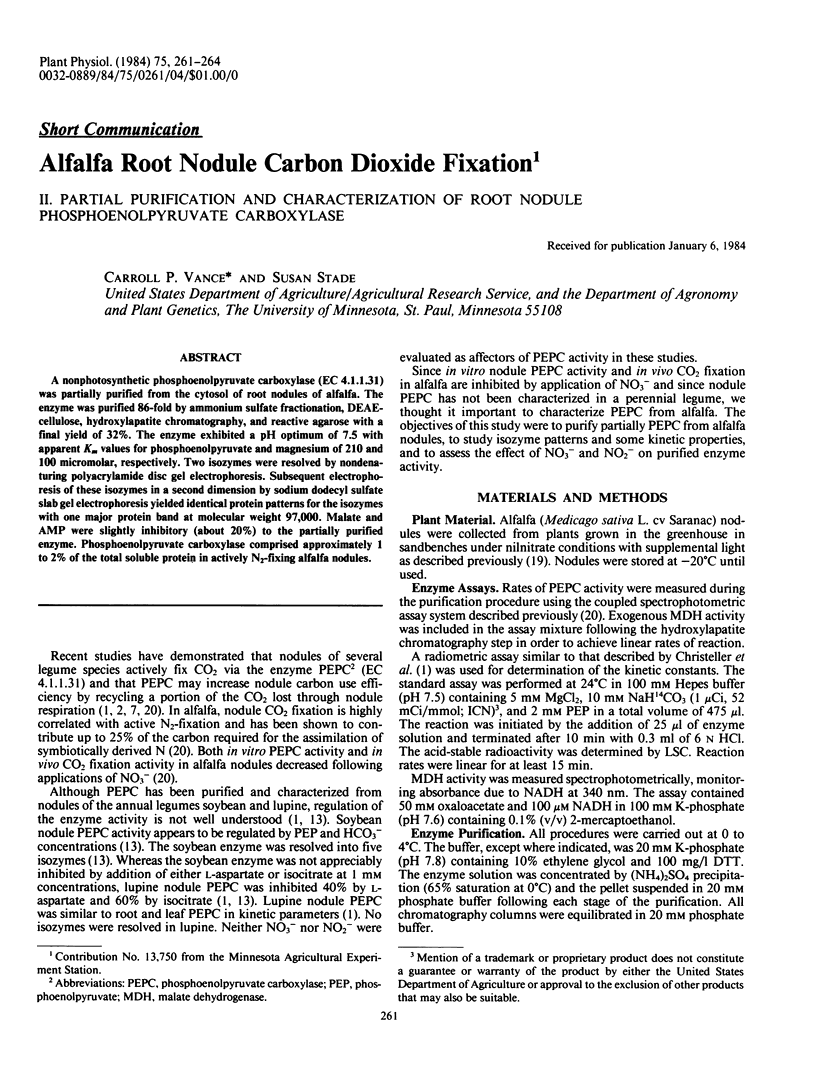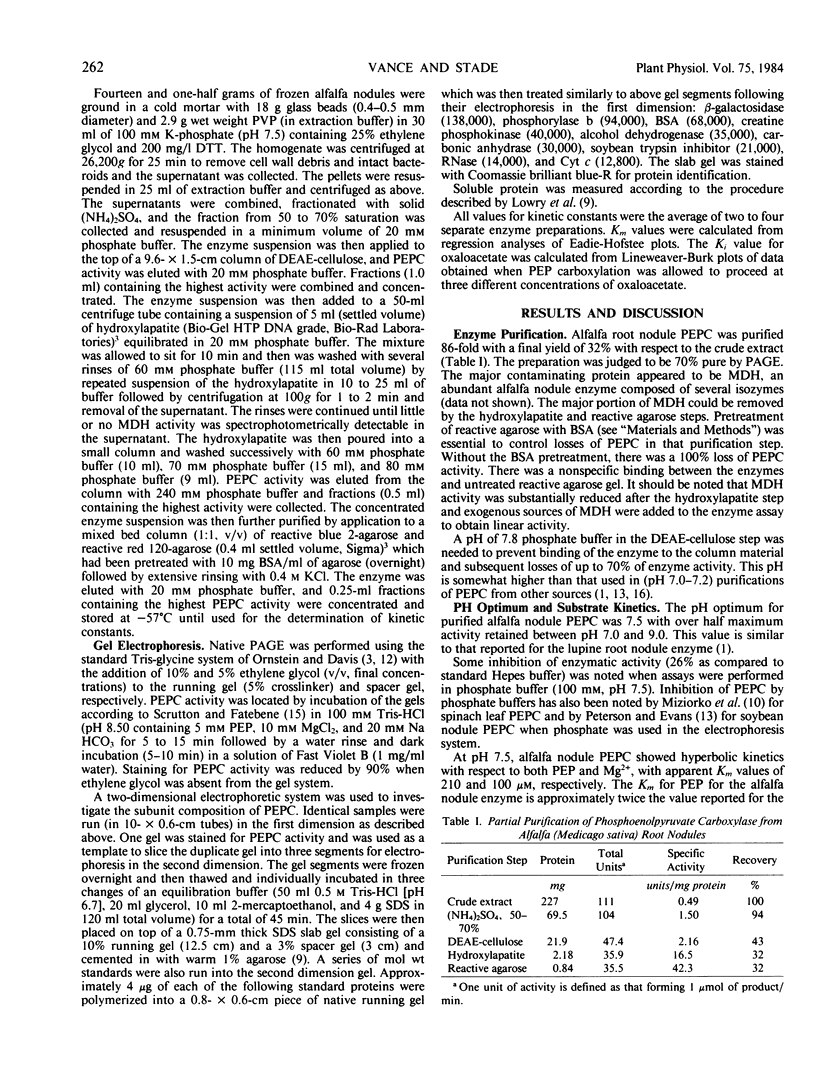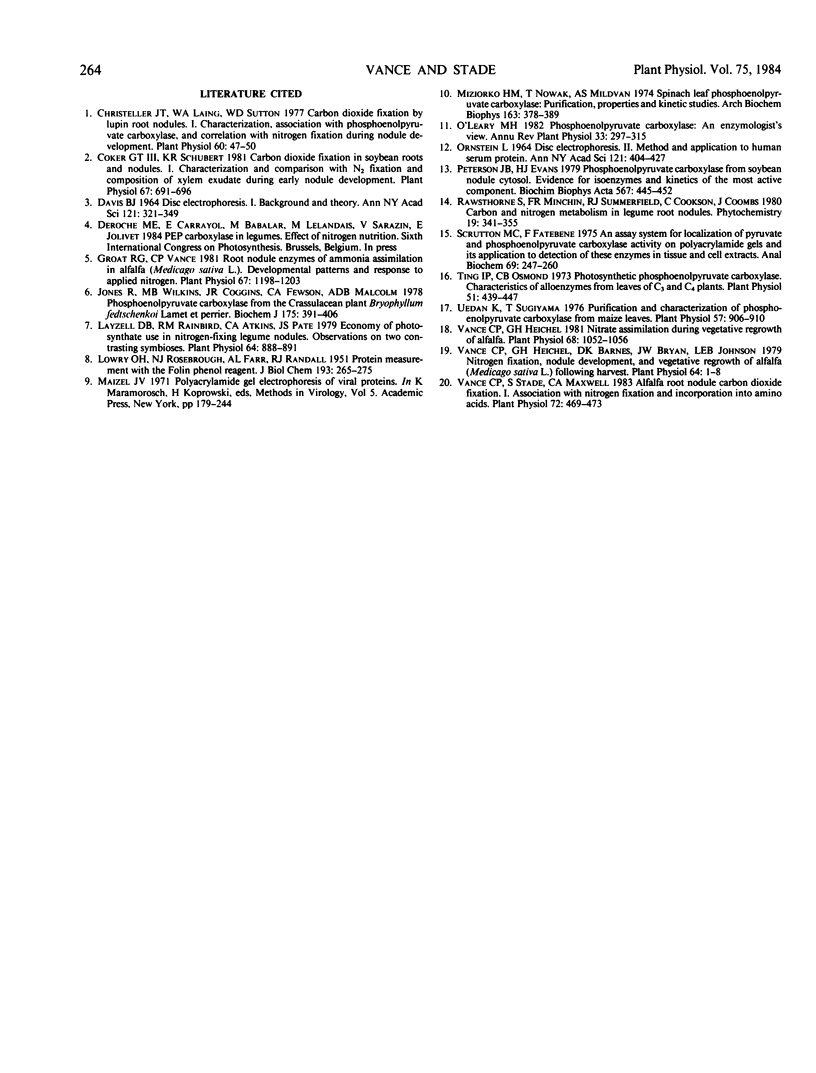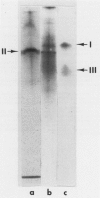Abstract
A nonphotosynthetic phosphoenolpyruvate carboxylase (EC 4.1.1.31) was partially purified from the cytosol of root nodules of alfalfa. The enzyme was purified 86-fold by ammonium sulfate fractionation, DEAE-cellulose, hydroxylapatite chromatography, and reactive agarose with a final yield of 32%. The enzyme exhibited a pH optimum of 7.5 with apparent Km values for phosphoenolpyruvate and magnesium of 210 and 100 micromolar, respectively. Two isozymes were resolved by nondenaturing polyacrylamide disc gel electrophoresis. Subsequent electrophoresis of these isozymes in a second dimension by sodium dodecyl sulfate slab gel electrophoresis yielded identical protein patterns for the isozymes with one major protein band at molecular weight 97,000. Malate and AMP were slightly inhibitory (about 20%) to the partially purified enzyme. Phosphoenolpyruvate carboxylase comprised approximately 1 to 2% of the total soluble protein in actively N2-fixing alfalfa nodules.
Full text
PDF



Images in this article
Selected References
These references are in PubMed. This may not be the complete list of references from this article.
- Christeller J. T., Laing W. A., Sutton W. D. Carbon Dioxide Fixation by Lupin Root Nodules: I. Characterization, Association with Phosphoenolpyruvate Carboxylase, and Correlation with Nitrogen Fixation during Nodule Development. Plant Physiol. 1977 Jul;60(1):47–50. doi: 10.1104/pp.60.1.47. [DOI] [PMC free article] [PubMed] [Google Scholar]
- Coker G. T., Schubert K. R. Carbon Dioxide Fixation in Soybean Roots and Nodules: I. CHARACTERIZATION AND COMPARISON WITH N(2) FIXATION AND COMPOSITION OF XYLEM EXUDATE DURING EARLY NODULE DEVELOPMENT. Plant Physiol. 1981 Apr;67(4):691–696. doi: 10.1104/pp.67.4.691. [DOI] [PMC free article] [PubMed] [Google Scholar]
- DAVIS B. J. DISC ELECTROPHORESIS. II. METHOD AND APPLICATION TO HUMAN SERUM PROTEINS. Ann N Y Acad Sci. 1964 Dec 28;121:404–427. doi: 10.1111/j.1749-6632.1964.tb14213.x. [DOI] [PubMed] [Google Scholar]
- Groat R. G., Vance C. P. Root Nodule Enzymes of Ammonia Assimilation in Alfalfa (Medicago sativa L.) : DEVELOPMENTAL PATTERNS AND RESPONSE TO APPLIED NITROGEN. Plant Physiol. 1981 Jun;67(6):1198–1203. doi: 10.1104/pp.67.6.1198. [DOI] [PMC free article] [PubMed] [Google Scholar]
- Jones R., Wilkins M. B., Coggins J. R., Fewson C. A., Malcolm A. D. Phosphoenolpyruvate carboxylase from the crassulacean plant Bryophyllum fedtschenkoi Hamet et Perrier. Purification, molecular and kinetic properties. Biochem J. 1978 Nov 1;175(2):391–406. doi: 10.1042/bj1750391. [DOI] [PMC free article] [PubMed] [Google Scholar]
- LOWRY O. H., ROSEBROUGH N. J., FARR A. L., RANDALL R. J. Protein measurement with the Folin phenol reagent. J Biol Chem. 1951 Nov;193(1):265–275. [PubMed] [Google Scholar]
- Layzell D. B., Rainbird R. M., Atkins C. A., Pate J. S. Economy of Photosynthate Use in Nitrogen-fixing Legume Nodules: Observations on Two Contrasting Symbioses. Plant Physiol. 1979 Nov;64(5):888–891. doi: 10.1104/pp.64.5.888. [DOI] [PMC free article] [PubMed] [Google Scholar]
- Miziorko H. M., Nowak T., Mildvan A. S. Spinach leaf phosphoenolpyruvate carboxylase: purification, properties, and kinetic studies. Arch Biochem Biophys. 1974 Jul;163(1):378–389. doi: 10.1016/0003-9861(74)90489-5. [DOI] [PubMed] [Google Scholar]
- Peterson J. B., Evans H. J. Phosphoenolpyruvate carboxylase from soybean nodule cytosol. Evidence for isoenzymes and kinetics of the most active component. Biochim Biophys Acta. 1979 Apr 12;567(2):445–452. doi: 10.1016/0005-2744(79)90130-x. [DOI] [PubMed] [Google Scholar]
- Scrutton M. C., Fatebene F. An assay system for localisation of pyruvate and phosphoenolpyruvate carboxylase activity on polyacrylamide gels and its application to detection of these enzymes in tissue and cell extracts. Anal Biochem. 1975 Nov;69(1):247–260. doi: 10.1016/0003-2697(75)90584-9. [DOI] [PubMed] [Google Scholar]
- Ting I. P., Osmond C. B. Photosynthetic phosphoenolpyruvate carboxylases: characteristics of alloenzymes from leaves of c(3) and c(1) plants. Plant Physiol. 1973 Mar;51(3):439–447. doi: 10.1104/pp.51.3.439. [DOI] [PMC free article] [PubMed] [Google Scholar]
- Uedan K., Sugiyama T. Purification and characterization of phosphoenolpyruvate carboxylase from maize leaves. Plant Physiol. 1976 Jun;57(6):906–910. doi: 10.1104/pp.57.6.906. [DOI] [PMC free article] [PubMed] [Google Scholar]
- Vance C. P., Heichel G. H., Barnes D. K., Bryan J. W., Johnson L. E. Nitrogen Fixation, Nodule Development, and Vegetative Regrowth of Alfalfa (Medicago sativa L.) following Harvest. Plant Physiol. 1979 Jul;64(1):1–8. doi: 10.1104/pp.64.1.1. [DOI] [PMC free article] [PubMed] [Google Scholar]
- Vance C. P., Heichel G. H. Nitrate Assimilation during Vegetative Regrowth of Alfalfa. Plant Physiol. 1981 Nov;68(5):1052–1057. doi: 10.1104/pp.68.5.1052. [DOI] [PMC free article] [PubMed] [Google Scholar]
- Vance C. P., Stade S., Maxwell C. A. Alfalfa root nodule carbon dioxide fixation : I. Association with nitrogen fixation and incorporation into amino acids. Plant Physiol. 1983 Jun;72(2):469–473. doi: 10.1104/pp.72.2.469. [DOI] [PMC free article] [PubMed] [Google Scholar]



